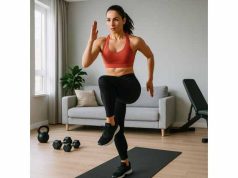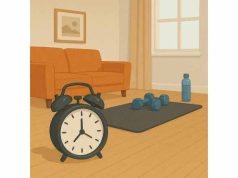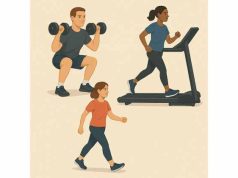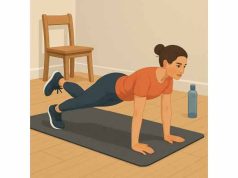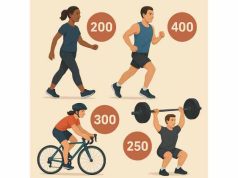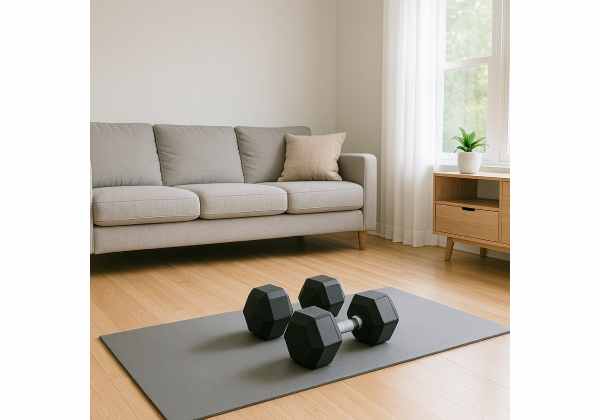
Strength training is one of the most reliable ways to change your body during a fat-loss phase. You build and protect muscle, raise daily energy use, and feel stronger in everyday tasks. Dumbbells make that work practical at home: they are compact, versatile, and suitable for all levels. This guide gives you a complete full-body program, clear technique cues, and week-by-week progressions. You will learn how to pair lifting with steps and simple cardio so results are steady rather than dramatic and short-lived. For the wider framework that blends strength, cardio, and walking into one plan, see our concise primer on evidence-based exercise strategies for losing fat.
Table of Contents
- Why dumbbells aid fat loss
- Program structure at home
- Full-body dumbbell workout
- Progression and loading
- Cardio add-ons and steps
- Nutrition and recovery basics
- Form cues and safety
- Frequently Asked Questions
Why dumbbells aid fat loss
Fat loss is driven by a consistent calorie deficit. Strength training decides what you keep. When you lift, the body receives a clear signal to preserve muscle tissue. More lean mass supports a higher resting energy use and better shape as the scale moves. Dumbbells deliver that signal efficiently at home because they allow full-range, compound movements with minimal setup and little joint stress.
Key advantages for weight loss:
- Big patterns with minimal friction. Squat, hinge, press, row, and carry cover the major muscle groups without machines. These patterns recruit a large amount of muscle, raising the energy cost per session.
- Progression without complexity. You can make a set harder by adding load, slowing the lowering phase, pausing at the bottom, changing leverage (e.g., split stance), or increasing total work. This keeps training effective even if you own only one or two pairs of dumbbells.
- Joint-friendly intensity. Compared with high-impact cardio, dumbbells let you work near muscular fatigue without pounding. That supports adherence and recovery—two pillars of successful fat loss.
- Flexible scheduling. You can complete a focused full-body session in 30–45 minutes. If life is busy, a short “A” or “B” workout still moves you forward.
What results should you expect? With steady training, daily steps, and matched nutrition, most adults see improved performance in two to three weeks and measurable changes in waist or progress photos by weeks four to eight. If you want a brief refresher on pacing loss, portion control, and realistic timelines, scan our simple guidance on safe fat-loss basics and then return to the program below.
Common misconceptions to drop:
- “Light weights cannot help fat loss.” They can—if sets are taken close to technical failure and progressed over time. Tempo, range, and unilateral variations make moderate loads challenging.
- “Endless circuits beat strength work.” High-heart-rate circuits can be useful, but muscle-focused sets with orderly rest protect lean tissue better. You can blend both across the week.
Your action steps: choose two or three full-body sessions per week, repeat the same core lifts, and progress methodically. The templates that follow are built for reliability rather than novelty.
Program structure at home
A good home plan is simple, repeatable, and balanced. You will train the whole body each session with a focus on five patterns: squat, hinge, push, pull, and carry/core. Each workout includes a short warm-up, three strength blocks, and an optional finisher. The goal is high-quality sets taken close to fatigue without breaking form.
Weekly options
- 2-day plan (busy schedule): Mon and Thu or Tue and Fri. Alternate Workouts A and B.
- 3-day plan (recommended): Mon, Wed, Fri. Rotate A/B/A one week, then B/A/B the next.
- 4-day plan (shorter sessions): Upper-Lower split using the same movement families, 30–35 minutes each.
Session shape (35–45 minutes)
- Warm-up (5 minutes): brisk march or step-ups; hip hinges to wall; arm circles; 1–2 rehearsal sets with light dumbbells.
- Strength Blocks (25–35 minutes): two primary lifts (squat or hinge + press or row) for 3–4 sets, then an assistance tri-set.
- Optional finisher (3–6 minutes): short density work for heart rate and extra calorie burn.
Intensity and reps
- Use RIR (reps in reserve) to regulate effort. Most sets land at 1–2 RIR: you could perform one or two more clean reps.
- Default rep ranges: 6–10 for primary lifts, 8–15 for assistance, 20–40 seconds for carries and plank variations.
- Rest 60–90 seconds between sets of assistance work and 90–120 seconds for primary lifts.
Equipment and space
- One adjustable pair is ideal. If you have fixed pairs, keep two ranges (lighter for presses/raises, heavier for squats/hinges/rows).
- A sturdy chair or bench expands options (rear-foot-elevated split squat, hip thrust).
- A small floor area (2×2 m) is enough.
Where this fits in a broader plan
Two or three dumbbell sessions plus daily steps and one short cardio day create a sustainable weekly energy gap. If you want a ready-made three-day outline that pairs well with this program, see our simple beginner strength schedule.
Full-body dumbbell workout
Below are two complete sessions you can alternate for 8–12 weeks. Keep the exercises, improve the execution, and progress one small lever at a time. Each includes a warm-up, main lifts, assistance work, and an optional conditioning finisher.
Universal warm-up (5 minutes)
- 60–90 seconds brisk march or step-ups
- 10 hip hinges to wall + 10 ankle rocks
- 1 set of 8 goblet squats with a light weight
- 6–8 push-ups (hands elevated if needed)
For more detail on effective primers, see our brief guide to warm-up and mobility.
Workout A
- Goblet Squat — 4×6–10 @ 1–2 RIR; 2-second lower, 1-second pause.
- One-Arm Dumbbell Row — 4×8–12/side @ 1–2 RIR; full stretch at bottom.
- Floor or Bench Press — 3×8–12; light arch, shoulder blades set.
- Romanian Deadlift (DB RDL) — 3×8–12; hinge from hips, shins near vertical.
- Carry or Core: Suitcase Carry 3×20–40 m/side or Front Plank 3×25–40 s.
Optional finisher (4 minutes): 30 s alternating reverse lunges + 30 s rest × 4 rounds.
Workout B
- Split Squat (rear foot flat or elevated) — 4×8–12/side; knee tracks over mid-foot.
- One-Arm Overhead Press — 4×6–10/side; glutes tight, ribs down.
- Hip Thrust (shoulders on couch or floor) — 3×10–12; pause and squeeze at top.
- Chest-Supported Row (lie on bench or incline) — 3×8–12; pull elbows toward back pockets.
- Core rotation: Half-Kneeling Press-Out (Pallof style with band or hands press) 3×20–30 s/side.
Optional finisher (3–6 minutes): “DB complex” — 6 reps each: RDL → row → push press → front squat; rest 60–90 s; repeat 2–3 rounds with light-moderate weight.
Time-boxed 25-minute version
- Pick one primary lower (goblet squat or split squat) and one primary upper (row or press) for 3×8–12 each, then do a 10-minute assistance circuit: RDL 10, floor press 10, plank 30 s; repeat.
No heavy dumbbells? Make light weights effective.
- Tempo: 3-second lowers, 1-second pauses.
- Range: slow last third of the descent; pause just above the bottom.
- Unilateral: single-leg RDLs and split squats increase difficulty without more load.
- Density: reduce rest to 45–60 seconds on assistance sets.
Weekly templates
- Two days: Week 1 A/B; Week 2 A/B.
- Three days: Week 1 A/B/A; Week 2 B/A/B (alternate each week).
- Four shorter days: Mon A1 (lower-push focus), Tue B1 (upper-hinge focus), Thu A2, Fri B2; keep sets at 3.
Record the weight, reps, and RIR for your last set of each main lift. Aim to beat one number (weight, reps, or control) the next time that exercise appears.
Progression and loading
Progress keeps results moving even when calories are lower. Use the smallest effective change, and adjust one variable per week.
Primary lifts (goblet squat, split squat, RDL, press, row)
- When to add load: if you complete the top of the rep range at ≤1 RIR on at least two sets, increase dumbbell weight by the smallest available jump next session.
- When weight is fixed: add one rep per set, then add tempo (3-second lower) or a 1-second pause at the hardest point.
Assistance work
- Push reps toward the high end of the range with clean form. Reduce rest from 90 → 60 seconds before adding load.
Deload every 4–6 weeks**
- Reduce total sets by ~30–40%. Keep movement quality high; drop tempos and long pauses. You should leave the week feeling fresher.
Progression examples (8 weeks)
- Weeks 1–2: learn positions; 3×8–10 on mains, 3×10–12 assistance, 1–2 RIR.
- Weeks 3–4: 4×6–10 on mains; add a pause to squats and RDLs.
- Weeks 5–6: small load jump or +1 rep on each top set; finisher on two days.
- Week 7: deload.
- Week 8: retest key lifts (best clean set at 1 RIR) and update training maxes.
Session spacing
Most people recover well on a Mon/Wed/Fri or Tue/Thu/Sat rhythm. If soreness lingers, insert an extra rest day or reduce the finisher volume. For help with weekly spacing and rest, review our short guide on how to plan rest days.
When progress stalls (choose one)
- Add one assistance set (e.g., RDL 4× instead of 3×).
- Add 5–10 seconds to core holds or one carry lap.
- Slightly increase daily steps (see next section).
- Maintain training and tighten nutrition by ~200 calories/day from energy-dense extras.
Cardio add-ons and steps
Strength preserves muscle; daily movement and brief intervals raise weekly energy use without excessive fatigue.
Walks and NEAT
- Raise your baseline by 1,500–2,500 steps/day above current levels, then hold for two weeks. Layer short 10-minute walks after meals and use stairs where possible. For simple strategies that move the needle, see our quick overview of non-exercise activity.
Low-impact options between lift days
- Incline walking: 20–30 minutes at a brisk pace, 2–5% grade.
- Cycling or elliptical: 20–40 minutes at steady effort; nasal breathing most of the time.
Short interval ideas (1–2 times/week)**
Pick a low-impact modality and use one of the following, including warm-up and cool-down:
- 10×1′ hard / 1′ easy (15–20 minutes total).
- 4×3′ strong / 2′ easy (22–28 minutes).
Keep technique smooth. Intervals should feel hard but repeatable.
How much cardio?
Start with 90–150 minutes per week including steps. Add time gradually only if recovery, sleep, and lifting performance remain solid.
Nutrition and recovery basics
Training is the spark; nutrition and recovery determine the outcome. Aim for a modest, sustainable deficit and protect muscle with consistent protein.
Simple nutrition anchors
- Protein at each meal: most adults do well with 1.6–2.2 g/kg/day spread across 3–4 meals.
- Fiber and volume: include vegetables, fruit, legumes, and whole grains to support satiety.
- Portion control: keep calorie-dense extras (oils, sweets, alcohol) measured, not banned.
- Hydration: begin the day with water; sip during longer sessions.
Before and after sessions
- Pre (60–90 minutes): small carb + protein (yogurt and berries; toast and eggs).
- Post (within 2 hours): balanced meal with protein, carbs, and fluids. Avoid large “reward” snacks that erase the day’s work.
Sleep and stress
- Target 7–9 hours. Poor sleep increases hunger and reduces training quality.
- Use wind-down routines and consistent bedtimes.
Calorie numbers on devices
Treat watch estimates as trends, not facts. Focus on performance and weekly averages. For context about activity costs across modalities, our reference on typical calorie ranges by exercise can help you set expectations.
Form cues and safety
Good technique lets you train hard while protecting joints. Keep these cues brief and repeatable.
Goblet Squat
- Feet shoulder-width, toes slightly out.
- Inhale, brace lightly (“ribs down”), sit between the hips.
- Keep heels heavy; knees track over mid-foot.
- Pause just above your deepest good position; drive up.
Split Squat
- Short to medium stance; front shin near vertical at the bottom.
- Torso tall; light lean forward is acceptable.
- Press through the whole front foot; avoid collapsing inward.
DB RDL
- Soft knees, long spine.
- Push hips back until hamstrings load; dumbbells graze thighs.
- Keep lats engaged; do not round.
- Stand tall by driving hips forward, not by leaning back.
Row
- Support hand on bench or chair; spine long.
- Pull elbow toward back pocket; pause briefly; lower fully.
Press (floor or overhead)
- Set shoulder blades; wrists stacked over elbows.
- For overhead, squeeze glutes and keep ribs down.
Carries and planks
- Grow tall. For suitcase carries, resist leaning; walk slow and steady.
- In planks, breathe; avoid breath holding and low-back sag.
Who should seek clearance first
- Cardiovascular, metabolic, or orthopedic conditions; pregnancy or postpartum; recent surgery or injury; anyone returning after a long layoff. Start conservatively and progress gradually.
If a movement causes sharp pain, stop and modify. Reduce range, lighten load, or choose a friendlier variation (e.g., box squat, elevated push-up). Technique quality outweighs any single rep target.
Frequently Asked Questions
Can I lose weight with dumbbells only?
Yes. Combine two to three full-body dumbbell sessions per week with daily steps and a modest calorie deficit. Strength work preserves muscle while you reduce body fat. Track performance and weekly averages rather than relying on single-day scale changes.
How heavy should my dumbbells be for fat loss?
Choose weights that make the last 1–2 reps of a set challenging while maintaining form. If load options are limited, increase reps, add tempo or pauses, use unilateral variations, or shorten rest to raise difficulty without sacrificing technique.
How long should home workouts be?
Thirty-five to forty-five minutes is sufficient when you follow a clear structure: warm-up, two main lifts, assistance work, and an optional 3–6 minute finisher. On busy days, a focused 25-minute version still maintains momentum.
Do I need cardio if I lift with dumbbells?
You do not need long cardio sessions, but light-to-moderate movement between lift days helps create a sustainable deficit. Aim for walks and optional short intervals once or twice weekly, provided recovery and sleep remain solid.
How fast will I see results?
Most people notice better performance and posture within two to three weeks. Visible changes usually appear by weeks four to eight when training, steps, sleep, and nutrition align. A steady loss of 0.25–0.5 kg (0.5–1.0 lb) per week is a realistic target.
What if I only have one light pair?
Use techniques that raise challenge without more load: slow eccentrics, pauses near the bottom, one-and-a-half reps, and unilateral variations (split squats, single-arm presses, single-leg RDLs). Push sets close to fatigue while keeping form precise.
References
- Effect of exercise training on weight loss, body composition changes, and weight maintenance in adults with overweight or obesity: An overview of 12 systematic reviews and 149 studies (2021) (Systematic Review)
- Resistance training effectiveness on body composition and body weight outcomes in individuals with overweight and obesity across the lifespan: A systematic review and meta-analysis (2022) (Systematic Review & Meta-analysis)
- Systematic review and meta-analysis of protein intake to support muscle mass and function in healthy adults (2022) (Systematic Review & Meta-analysis)
- Energy deficiency impairs resistance training gains in lean mass but not strength: A meta-analysis and meta-regression (2022) (Meta-analysis)
- High-intensity interval training is not superior to continuous aerobic training in reducing body fat: A systematic review and meta-analysis of randomized clinical trials (2023) (Systematic Review & Meta-analysis)
Medical Disclaimer
This article is educational and does not replace personalized medical advice. Consult a qualified professional before changing your exercise or nutrition plan, especially if you have cardiovascular, metabolic, or orthopedic conditions; take medications that affect heart rate or balance; are pregnant or postpartum; or are returning after injury or surgery.
Share and Stay Connected
If this program was useful, consider sharing it with someone who trains at home and follow us on your preferred platform. Your support helps us continue producing clear, evidence-informed guides.


